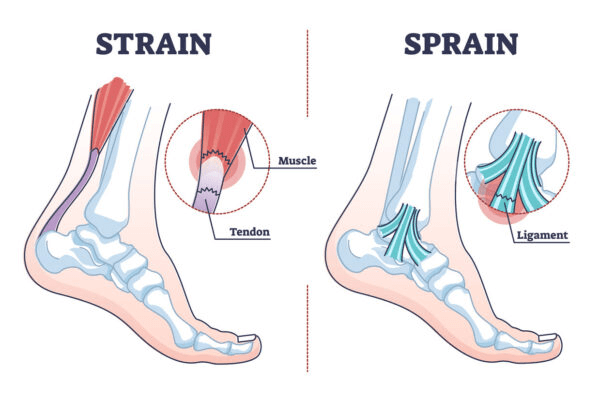
Sprain and strain are two terms which are frequently used when describing injuries and particularly injuries that have occurred due to physical activity or sports events. Although the two terms sprain and strain sound similar and can often be confused, they refer to distinct types of injuries affecting different structures of the body. It is essential to understand the difference between a sprain and a strain for a proper diagnosis, treatment and recovery from injury. This article will explain both strains and sprains in more detail, allowing us to help differentiate between them.
What is a Sprain?
A sprain involves the overstretching or tearing of ligaments. Ligaments are tough, fibrous tissues that connect bones to other bones, providing stability to joints. Sprains can occur commonly in areas such as the ankles, knees, and wrists, and are often the result of a fall, twist, or impact that forces a joint out of its normal position.
Symptoms of a Sprain:
- Swelling and bruising
- Pain around the affected joint
- Limited ability to move the joint
- A popping sensation at the time of injury (in severe cases)
Sprains are categorized into three grades based on their severity:
- Grade 1 (Mild): Ligaments are stretched but not torn. The joint remains stable, and there is minor pain and swelling.
- Grade 2 (Moderate): Partial tearing of the ligament. There is moderate pain, swelling, and bruising, along with some instability of the joint.
- Grade 3 (Severe): Complete tear of the ligament. The joint is unstable and cannot bear weight. Severe pain, swelling, and bruising are typical.
What is a Strain?
A strain, involves the overstretching or tearing of muscles or tendons. Tendons are the fibrous cords that attach muscles to bones. Strains can be caused from sudden, forceful contractions or overstretching of the muscles. Common sites for strains include areas such as the lower back, quadriceps and hamstring muscles.
Symptoms of a Strain:
- Swelling and bruising
- Pain and tenderness in the affected muscle or tendon
- Muscle spasms and cramping
- Weakness in the muscle
- Limited range of motion
Strains are also categorized into three grades based on their severity:
- Grade 1 (Mild): Slight overstretching or minor tearing of muscle fibres. There is mild pain and minimal loss of strength.
- Grade 2 (Moderate): More extensive tearing of muscle fibres, leading to significant pain, swelling, and bruising. There is noticeable loss of strength and function.
- Grade 3 (Severe): Complete rupture of the muscle or tendon. There is severe pain, swelling, and an inability to use the affected muscle.
Treatment and Recovery
Despite the clear differences in the tissues affected, the initial treatment for both sprains and strains commonly follows the R.I.C.E. protocol: Rest, Ice, Compression, and Elevation. This method helps reduce pain and swelling and promotes healing.
- Rest: Avoid using the injured area to prevent further damage.
- Ice: Apply ice packs to reduce swelling and numb the area.
- Compression: Use bandages to compress the area and reduce swelling.
- Elevation: Keep the injured area raised above heart level to minimize swelling.
Regardless of whether the injury is a sprain or strain and the level of severity (grade 1, 2 or 3), Sports Therapy treatment will always be of value to aid the healing process. Sports Therapy treatment with Jack or myself will allow for benefits such as a reduction in pain, increase in movement and decrease in stiffness to the affected area. Chiropractic adjustments will also be beneficial to a large amount of injuries especially any strains to the back or neck area, by aiding the neurological input to that structure, thus increasing healing.
Severe injuries (Grade 3) often require medical intervention, which may include immobilization, more intense Sports therapy/ physiotherapy treatment, or even surgery to repair torn ligaments, muscles, or tendons.
Prevention
Preventing sprains and strains involves maintaining good physical conditioning, warming up before activities, cooling down after activities, and using proper techniques and equipment. Strengthening exercises, flexibility training, and balance exercises can also reduce the risk of these injuries, which can be provided by the Sports Therapists here in clinic.
To conclude, while sprains and strains share some similarities in symptoms and initial treatment, they affect different parts of the musculoskeletal system and occur through different mechanisms. It is important to recognise the difference between a sprain and a strain as it is crucial for effective management and recovery, allowing individuals to return to their activities safely and efficiently. If you suspect you have a sprain or strain, please do get in touch with us at Care for Health for an accurate diagnosis and appropriate treatment plan.
Abi Wheatley (Sports Therapist)

